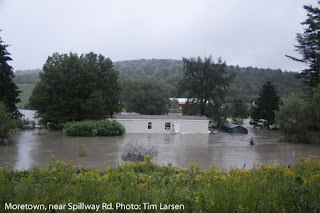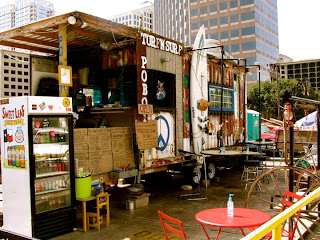Only two weeks ago, my home in Vermont was ravaged by the tropical storm Irene. While the meteorologists' projections positioned New York City and the Atlantic seaboard to receive the brunt of Mother Nature's rage; devastatingly, the area most affected by the storm was the mountainous region of little, good ole Vermont. With the steep topography of the my home base, Mad River Valley, and the wandering floodplain of the Mad River itself; Sunday, August 28th was one for the books.
It seemed like a normal day-just steady light rain. We were all following the news diligently to hear how our "armageddon hypothesizing" neighbors were dealing with the encroaching beast. All the while, the rivers were rising and rushing across agricultural fields, through people's basements, against the quintessential covered bridges and down the main streets of our quaint historic towns. I finally left the comfort of my house at 2:00 p.m.- thinking I was going to run a couple of errands downtown. After driving a few miles down the road, I quickly found myself face to face with a redirected raging river across the main highway. (This spot was later captured in a photo that graced the front page of The New York Times.) The Mad River had been let loose and taking anything in its way along for the ride.
While the flooding occurred without warning and with lightning speed, the response of the community was remarkable. Within hours, emergency response teams were dispersed and everyone had been evacuated (whether it was by canoe or foot) to higher ground.
The valley had never seen flooding so expansive and destructive since 1927. We awoke on Monday morning to a post-apocalyptic world. The late August sunshine illuminated the horror at every turn. The home of my office-1% For The Planet's headquarters- in the historic district of Waitsfield, had been destroyed. A sweet, picturesque gallery space across the street from us had been lifted from it's foundation and crashed into the building directly to its' left. Two large buildings, home to several businesses, had been inundated with 8 feet of raging flood water, and were now left with stores and restaurants filled to the brim with toxic silt and sludge. The covered bridge, the oldest bridge in the entire state, was closed indefinitely, and our entire street went from one of the valley's biggest tourist destinations to a post battle war zone. Somehow our 150 year old building only suffered from a sludge filled basement-most likely due to the strategic placement of the mobile building across the street blocking the brunt of the redirected river- and it's business as usual once the doors are closed to the catastrophe outside. Yet, it will never be business as usual on this street, in this valley or in the state of Vermont ever again. The flood will be remembered as a turning point-transforming the landscape of our lives and the unique culture of Vermont style.
All across the Valley and throughout the state of Vermont, regions were hit as hard or even worse than our idyllic community. Below is an assortment of photos to visualize the extent of devastation induced within a few ungodly hours on a Sunday afternoon.
Rivers carried silt and sludge along their paths as they picked up toxic petroleum chemicals, wastewater and agricultural runoff.
Entire roadways were demolished within hours.
Rochester's cemetery unearthed.
Yestermorrow's neighboring biodynamic farm, Small Step, was ruined by floodwaters spanning across the entirety of its' crops.
All crops exposed to the floodwaters are deemed unsuitable for consumption. We had to dig up all the crops at the peak of their harvest and burn them.
Even with the unquantifiable expanse of destruction, the community immediately came together in solidarity to remedy the mess left by Irene. At daybreak on Monday morning, individuals were mobilizing volunteers and supplies to locations in need. In the week following, every minute of the day was occupied with relief efforts: through volunteering, orchestrating fundraisers and clothing drives, road crews attacking the deteriorating roadways, and preparing meals for the thousands of workers devoted to restoring the beauty and local flare of our valley. All of this was in place before anyone even mentioned FEMA or the Red Cross. I heard a local woman say "this is my home, it's our responsibility." Through this nightmare, I have learned to true essence of resilience. I am living in one of the most resilient and inspiring communities I have ever come across. Amidst the devastation, the power of people to mobilize and fight for the greater good makes us refocus our perception of place-the valley and its' history-not as a building or street, but as the story of it's people and their pure strength and compassion during the most difficult of times.
Bridge Street amidst the clean up.
My coworkers wrapping up a long day at Small Step Farm. One of the many volunteer work days we have been involved in during the past two weeks.
As we move on from this travesty, larger picture questions are circulating amongst the community involving public health, rebuilding in a regenerative manner, storm water management, mitigating toxic pollution, revitalizing agricultural areas with depleted topsoil, etc. We will need to question the historical trajectory of community planning, and thoughtfully ponder what is the true essence of resilience. How is that reflection transcribed into design on an individual homestead scale, community scope and regional landscape? With respect to the historical framework of the valley, the question of time will arise. When will it be appropriate to follow suit with the flood's induced turning point of life in the Mad River Valley? When will we learn to respect nature and design accordingly. The platform for a cultural shift and design transformation has been put forth-it's time to execute the new beginning for the Mad River Valley in its' true fearless, unified, and resilient nature.
--
Here's a great link to more photos of the wreckage and the awakening of hope:
https://www.facebook.com/MRVpostIrene?sk=photos
Video of covered bridge destruction:
http://www.valleyreporter.com/index.php?option=com_content&task=view&id=4175&Itemid=38
Article on Mad River Valley organizations working towards fundraising and awareness:
http://www.valleyreporter.com/index.php?option=com_content&task=view&id=4186&Itemid=38
Article on farm devastation throughout the Mad River Valley:
http://www.valleyreporter.com/index.php?option=com_content&task=view&id=4185&Itemid=38
Article regarding cleanup efforts:
http://www.valleyreporter.com/index.php?option=com_content&task=view&id=4188&Itemid=38
Synopsis of clean up and economic recovery:
http://www.valleyreporter.com/index.php?option=com_content&task=view&id=4215&ac=0&Itemid=38


















































